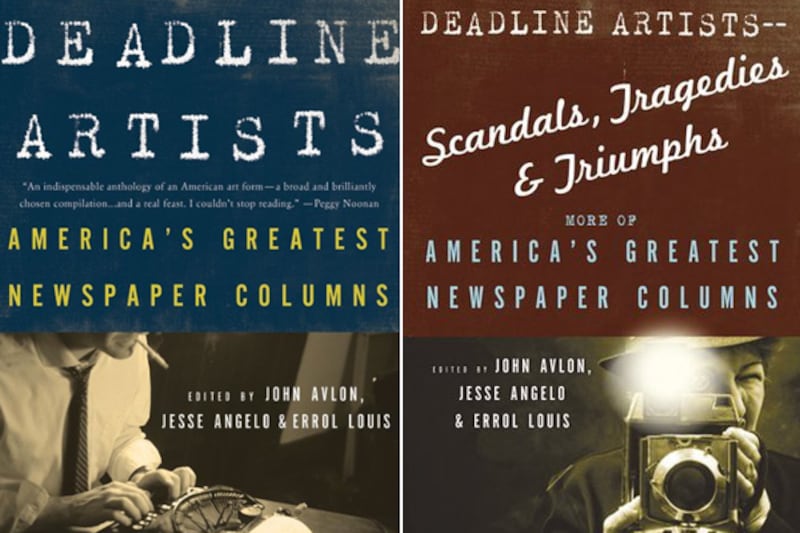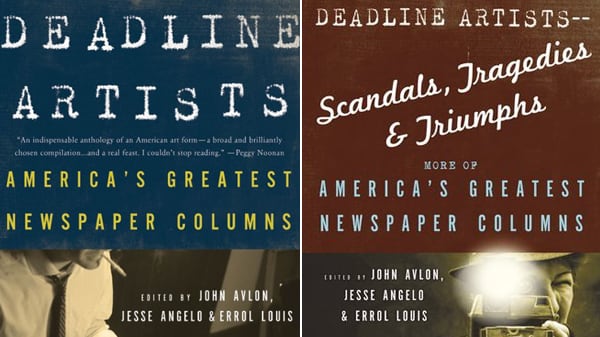If you find romance in the glories of the Newspaper Era, you ought to be able to find great satisfaction in a volume of old newspaper clippings.

Of course, it's always a little disappointing not to read them in their original state, as you can on microfilm or in bound volumes you lug down from a dusty library shelf and spread across a table, when they're available. The immediacy of the original print environment is a big part of their appeal, from the blotchy old type to the photos to the surrounding ads and articles.
But when I first borrowed a copy of The World and the 20s from my local public library sometime around 1982, it was for me an unbelievable immersion in the history of the decade—more genuine than any of the classic mob tales I'd been watching on television or in movies that pushed me to check the book out in the first place. Joseph Pulitzer's paper was crackling with energy at a time when society needed minding and many of the other papers seemed to be getting crushed under the weight of their own seriousness, or right-thinking bromidal writing; and, more importantly, oblivious to the rapidly expanding audience of New York’s intelligent but politically unpredictable immigrants.
It was for Pulitzer's paper that the original gonzo, Nellie Bly, beat Jules Verne's fictional protagonist and circumnavigated the globe in 72 days, writing dispatches as she went; by the 1920s the publication was much bigger than that, and a little less fantastical in its editorial enterprises, but all the more central to the life of the city and the world.
The World and the 20s is long out of print. And it's not my business to lecture editors John Avlon, Jesse Angelo, and Errol Louis, whose recently released collection of newspaper columns is out now from Overlook Press, on the likely small size of their audience. After all, this is a sequel to Deadline Artists: America’s Greatest Newspaper Columns, and I don't imagine financial pressures on Overlook would allow a second simply as a matter of indulgence.
But this second volume of Deadline Artists, with the subheading Scandals, Tragedies & Triumphs: More of America's Greatest Newspaper Columns, is a welcome indulgence to me, even if I have some quibbles with it.
In the introduction, the editors—Avlon is a former New York Sun columnist who’s now with The Daily Beast; News Corp. veteran Angelo is a young guy who nevertheless has lots of years behind him at several papers, including the New York Post, and, until this week, The Daily; and Errol Louis, a former political columnist for The New York Sun and the New York Daily News, and now the host of NY1’s Inside City Hall—let their nostalgia flag fly:
"What makes a newspaper column retain its power after the moment has passed? A clear voice and compelling storytelling—vivid descriptive writing delivered with punch and panache, pitting heroes against villains and offering flashes of wit and wisdom in the balance. It entertains as it educates."
I have no doubt this is a fair assessment of what many of the best columnists do, though it's incomplete. Some of the best ones really couldn't write, but they saw beautifully; others never got more than a yard from their desk ashtrays, but their prose was magic. And I found it hard to put down this anthology, in which I was able to reread lots of stuff I don't get to read enough, from Ernest Hemingway's personal accounts of bullfighting in Spain to Jack London's travelogue from earthquake-devastated San Francisco to Shirley Povich's simple and yet stirring account of Don Larsen's perfect game in the World Series in 1956.
Legally or not, all three can be found on the Internet today, but what makes an anthology like this matter is its ability to bundle all of this stuff together and give us something broad to think about American thought and history.
I was so pleased to land on the famous lede to Povich's piece in this collection; it's a deceptively simple string of cliches that, for young writers, should come with a warning not to try this at home, kids:
"The million-to-one shot came in. Hell froze over. A month of Sundays hit the calendar. Don Larsen today pitched a no-hit, no-run, no-man-reach-first game in a World Series."
Which is why it seemed such a disappointment to end the anthology with Peggy Noonan’s weak reflection of that article, a meditation on the injustice of the bad umpire’s call that cost Detroit Tigers pitcher Armando Galarraga a perfect game. (It opens: “We needed some happy news this week, and I think we got it. But first, a journey back in time.) The five decades between Povich and Noonan's pieces mean, for sure, that Noonan's flourishes will look more accomplished, or at least familiar, to a contemporary reader. But the energy in it feels a bit like a fake, a time and place in sportswriting which an attempt by the wrong hands to recapture really destroys.
This comparison, reached at the end, made me a bit more honest about what I'd just read. Is it only time and an inability for me to sink myself into period style that made me really want to skip Damon Runyon's account of the trial of Al Capone? It reminds me of a complaint I often hear from my father, who repeatedly makes the mistake of watching old movies he once loved on Netflix. Were the movies that I thought I loved always this bad?
I mean, I’d only ever applied the term “Runyonesque” to someone’s writing as a jab. And yet if you’d asked me before I picked up this book what I thought of Runyon, not having read a word of him in literally decades, I think I’d have relied on memory and said, “Well, he’s one of the greats.” So it was a bit sad to find myself reacting the way I did to some of the “greats” selected here. This in many ways goes to the quote from the introduction I offered before. What makes a column stand the test of time? And is standing the test of time the test for anthologizing them too? I think it depends what you’re trying to do.
By way of contrast to Runyon, I was dazzled by Chicago Daily News columnist Ben Hecht's tour through sleepy Wheaton, Ill., the night before a murderer sentenced to die by hanging was to get the rope. I don't think I'd particularly heard of Hecht before, and certainly never the tabloid-fodder murder that resulted in this sad execution day. There's too much to quote, but here:
“We walked through the summer night to the sheriff’s house adjoining the jail. We wanted his opinion on [the condemned man’s] new soul. But the sheriff had gone to bed early and left word that no one was to disturb him.
“‘Another frightened man,’ said Wallace. ‘I talked to him this morning. He was shaking like a mongoose. He’s not only never hanged anybody but he’s never even seen a hanging. The whole thing is very upsetting to him.’”
From there, there is the sheriff's daughter oiling the rope, and, to the reporter's horror telling him that if he'd lived in Wheaton all his life he might see what she was so excited about; there's the town gathering, the local columnist speculating that the height of the gallows was all about a sweet lumber contract. Before all that, a description of the crime so vivid and so mythic that it put me in mind of Smeagol and Deagol on the banks of the river in the prehistory of The Lord of the Rings, or a short story by Flannery O'Connor or Shirley Jackson.
I guess that's one thing that books like this will always have over digital media, and it's something that I've heard devoted print readers in general say before: There is precious little felicity of discovery in Google Books. As much as it feels like each link leading to the next is a journey of discovery, the economy of the Internet is conspiring to make your needs and desires more predictable, so they can be served more readily, which is to say to the exclusion of random luck. I would never have searched for Hecht's column, but (and this is partly a function of my peculiar line of work) I may well have searched for Runyon's.
I shouldn't end without pointing out one other slightly depressing element of this book, which is that certain "great moments in history" were not necessarily great moments in column writing. The San Francisco Earthquake, I suspect, is here because of what Jack London made of it.
“The man in front me on the car had floated all Monday night with his wife and mother on a part of the roof of his little house. He told me that he kissed his wife good-bye at midnight and told her he could not hold on any longer, but he did hold on, dazed and half conscious, until the day broke and showed him that he was alone on his piece of dried wood. He did not even know when the women that he loved had died.”
But beyond the historical importance of the liberation of Dachau I'm not sure that Marguerite Higgins's account, even though it was among the very first, would be worth including in a volume of this size. It's as after sharing the columns they loved, the editors felt there were a bunch of events they needed to find columns to cover. Before you scold me: I know how famous Higgins is, and how important she was. But you should read this yourself if you think that that's not too low a bar.
It's this kind of goal orientation that I think contributes the weakest selections to this book. After all, there's no Dorothy Rabinowitz in here; despite our differences, I love to read her almost every time. So maybe there are Dorothy Rabinowitzes missing from the inclusions in the first 60 years here, too?
There's something many of the more recent columns that made the collection’s cut that rankles. Often they are loose moral harangues to the reader, or little, wispy, unreported essays of the "what's-this-world-coming-to" variety—even from writers who have proven capable of better work. In many cases I remember the columns here, and I remember them as fish wrap—and the sort that self-consciously evoked fish wrap of fish long gone by.
As the "intellectual strip-tease" number in the musical Pal Joey begins: "Zip! Walter Lippman wasn't brilliant today ..." And really, he can't be brilliant every day; the stripper singing it at all proves that, on balance, he was. But the Lippman we read in a bound anthology, one that means to peek out at us from our bookshelf as we bounce our way around the Internet, should be nothing less.
And at its best, Deadline Artists provides that, a collection of the vital voices that delivered a first draft of history that’s worth revisiting.
"[The] once towering power of individual columnists on the editorial page has faded somewhat with the comparative democracy of different voices available on the Internet," the introduction reads in part, carefully sidestepping what might be read as a naive lament. But that's what this book is, in part. And, on the whole, it's something I am willing to indulge in the editors, because I profited from indulging in it myself.





